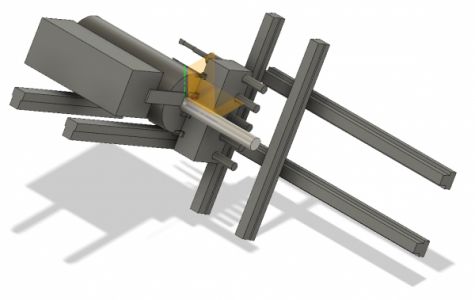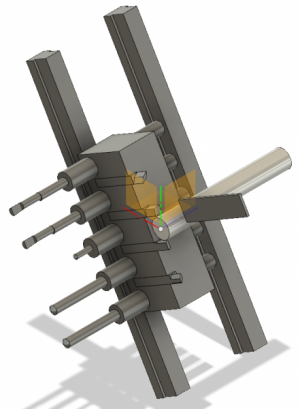Here's a concept of the idea I mentioned earlier, about adding a true third axis to the lathe by moving the head stock.

If a 2-axis is a 'slant bed,' this would be a 'V bed.' Here are the high points;
1) I'm designing from the cut area outward, hence the floating parts
2) X axis is kicked up 60degrees, with about 3.5" of travel up and down from the position shown (it's the steep axis on the right in this view)
3) Y axis is therefore 30degrees above horizontal, the spindle & motor will move along this. Motion is about 1.5" up/out, 4" down/in (more later)
3a) Servo motor points down & hangs between the axis rails
4) Z axis is a normal left/right orientation, with 12" of travel to the right from the position shown (more later)
4a) Servo motor at the same elevation as the upper/back Z rail, behind the spindle

Tool plate layout (opposite angle to the first view, spindle/motor/Y&Z axes hidden). Like I said, I've been around Swiss lathes a lot lately, so the thing I have here is almost a hybrid of a gang-plate and a dog-leg;
1) Turning tools sit atop a post clamped into the tool plate. Rather than the cut load trying to 'bend' the tool, it is trying to 'compress' the shank
1a) Tool shanks secured in a slot by a wedge-clamp (probably a standard Swiss format clamp)
1b) The 'post' presenting the tool will have a cutting edge on its top & bottom side, so a left-hand tool can be used if the spindle is reversed
1c) If possible, a symmetric insert laid orthogonal to the XZ plane will accomplish 1b, cutting on both exposed edges
1d) The tools are selected by raising the headstock, sliding the tool plate to another 'gap' between cutters, and dropping the workpiece back down
2) Drilling and boring tools are located below the stack of turning tools, held in ER16 collet holders bolted into the tool plate
2a) These tools are accessed by sliding the toolplate about 4" along Z, then dropping the headstock down near its limit of travel
2b) To make room for these tools' stick-out, the Y axis rails move with the headstock (the carriages are fixed)
2c) These tools are 3" below the C/L of the turning tools, so with proper caution objects as large as the spindle OD can be swung if needed
3) The headstock moves up .6" to clear the turning tools; as it moves another .6" upward it hits a frame-mounted parting blade near the collet
4) The four tool spots up top are; L/R 55deg roughing insert, L/R 36deg finishing insert, HSS round/square grooving, HSS L/R 60deg thread
5) The five ER16 parts are; spot drill, two twist drills, ID boring tool, ID threading tool
Things I like about the idea so far;
1) Drills can be as long as the spindle if needed (or bore 6" deep in a 6" part)
2) Very high density of tooling; I have 14 cutting edges shown, all available at all times (for 99% of operations I'm likely to need)
3) Possibility of small live air-tools in the ER16 holder spots (some day)
4) Possibility of a live air-tool in the 3/8" bar slots (though it would block a number of other tool positions)
5) Mirrored turning tools could be mounted at the right-side of the tool plate, for turning a larger area than allowed by the Z travel alone
6) Tool changes seem like they would be very fast; as fast as rapiding to any particular point on a mill
7) The X and Y support beams will form an X truss in the frame
8) Possbility of a tailstock since the workpiece goes right over the top of the toolplate
9) It's really easy to blank off the Y-axis stuff & have my 2-axis layout if I decide not to go 3-axis

Things I don't like;
1) Very careful programming & sequencing would be needed for everything, since crash-points are everywhere (just like a Swiss)
2) Would need to grind custom insert holders & HSS tools for the turning positions since the orientation is unusual (roller-box tool bits are similar)
2a) I honestly don't know if that sort of tool/workpiece arrangement even works w/o rollers; usually tools are loaded on the side, not the end
3) The spindle is cantilevered off its supports when it drops down to align with the drilling tools (about 3 inches)
4) The headstock gets a little complicated compared to bolting a spindle cartridge to a thick plate on the frame
5) Moving headstock likely makes powered collet actuation more difficult
6) One more degree of backlash on a light weight machine to worry about (but mills get by, so maybe not a big issue in practice)
7) Wild guess that the moving head-stock end will make coolant & chip-guarding more difficult
8) No good spots to put the X-axis servo motor; an 8:1 in-line planetary might be the best route for this one axis
9) As modeled, it's about a foot from the door to the Y axis rails to the spindle C/L; this seems awkwardly deep for access
9a) Tool setting looks at least as tight & awkward as for Swiss lathes




 But a very interesting concept.
But a very interesting concept.